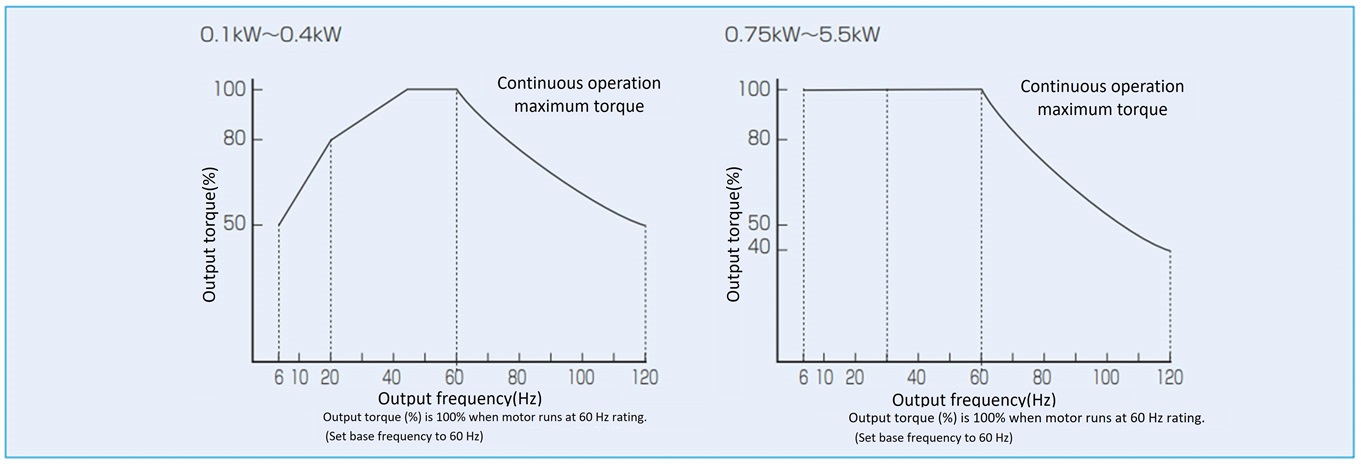Technical Data Reducers Worm Gear Reducers Motor Specifications
Operation using an inverter (For inverter drive with standard motor )
1. Frequency range
Maximum 120 Hz. In the low-Hz range (low frequency), use within the allowable range of the inverter.
2. Torque characteristics
For the frequency and torque characteristics, refer to the following graphs.- ・At high speeds, torque decreases inversely in proportion to the rotation speed because the power becomes constant at kW. As the speed increases, so does the vibration and operating noise of the motor and fan, and the reduction portion.
- ・In mid speed ranges, output torque is basically at its rated torque.
- ・At low speeds, the operating and cooling efficiency of the motor decreases, so temperature raises. To prevent these effects from occurring, make sure to lower the torque as shown in the graph below.
(0.1 to 0.4 kW motors only )
Note) Torque characteristics shown here are only for the motor itself.
Troi Drive and Worm Power Drive efficiencies must be taken into consideration.
3. Brake type
- ・When using an inverter, always wire the brake circuit referring to the diagram and control the brake individually. Standard products are shipped with the brake lead wire screwed together with the motor lead wire. The brake lead wire should be unscrewed and connected individually.
- ・Perform braking at 60 Hz (1800 r/min) or less speed. Braking at high speed ranges above 60 Hz may cause mechanical damage or abnormal abrasion wear on the brake linings.
- ・Low speed operation also lowers the motor’s cooling capacity which can reduce the life of the motor in terms of thermal resistance. In such cases, reduce the duty of the brake under power.
4. Notes
- ・When using a motor with a low frequency or with a frequency of 60 Hz or higher, lower the torque as shown in the graphs above.
- ・When using inverter drive with a 400 V-class motor, dielectric breakdown may occur due to a high-voltage surge (micro surge) that occurs with switching of the inverter. Countermeasures are therefore needed for the motor (micro surge protection). Standard 400 V-class-and-higher motors come standard with micro surge protection. However, with levels in excess of 1250 V, a suppression filter or reactor should be installed on the inverter side.
- ・Compared with standard power supplies, the inverter drive is greater increases in temperature, noise, and vibration should be expected.
- ・To protect the motor from overheating, use an electronic thermal mechanism configured to general-purpose motor characteristics, or use a thermal relay or other device between the inverter and the motor.
- ・When using at a base frequency of 50 Hz, set the output torque to 0.8 times that in the chart above. (With 0.4 kW or less motors only )
- ・The motor may resonate depending on the rotating speed and frequency. When operating continuously, avoid the resonance frequency by, for example, changing the carrier frequency setting of the inverter.
- ・When test running under light loads, the motor may draw a large current at low frequencies. This is due to motor characteristics and does not indicate an abnormal condition. It is possible to decrease the current by changing the setting of the inverter (reducing the torque boost, reducing the V/F ratio, and/or adjusting the torque vector).
- ・Continuous operation at frequencies above 60 Hz will cause the reducer to heat up and should be avoided. Contact Tsubaki representative for details.
With variable frequency driven motor
Inverter motors are available for motor size 0.1 kW to 0.4 kW. Please consult us for details.

